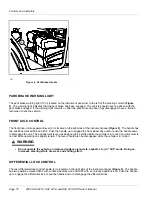
Maintenance
4.5. Plug the fuel tank vent nipple so that it is air tight. Husqvarna recommends using a slip-on vinyl cap.
5.
Remove both spark plugs, and pour 1/2 ounce (14.2 mL) of SAE 10 weight oil through each of the two spark plug
holes. Rotate the engine crankshaft by hand several times, then install both spark plugs.
6.
Change engine oil.
See Engine Oil and Filter Change on page 36.
7.
Disconnect the battery cables, negative (–) cable first.
See WARNING “To avoid unintentionally starting...” in
General Warnings on page 10.
8.
The battery should be clean and free of corrosion. Wash the battery top and terminals with a solution of baking
soda and water (1 cup (237 mL) baking soda per 1 gallon (3.8 L) of water). Rinse the solution off the battery. Do
not allow this solution to enter the battery. Be sure the terminals are tight. Let the terminals dry and then coat
them with Battery Terminal Protector Spray (P/N 603 00 00-03).
9.
Adjust the tires to the recommended tire pressure.
See Vehicle Specifications on page 48.
10. Perform semiannual periodic lubrication.
See Periodic Lubrication Schedule on page 33.
11. Thoroughly clean the front body, rear body, seats, cargo bed, engine compartment, and underside of vehicle.
12. Do not engage the park brake. Chock the wheels to prevent the vehicle from rolling.
RETURNING THE STORED VEHICLE TO SERVICE
1.
Make sure the key switch is in the OFF position and the Forward/Reverse handle is in the NEUTRAL position.
Chock the wheels.
2.
Restore the fuel system to operation.
2.1. Remove the plug from the fuel tank vent.
2.2. Connect the vent tube to the fuel tank vent.
3.
Connect the battery cables, positive (+) cable first, and tighten the terminals to 80 in-lb (9 N·m). Coat terminals
with Battery Terminal Protector Spray (P/N 603 00 00-03).
4.
Completely open the fuel shut-off valve
(Figure 11, Page 29)
. Ensure the valve is fully open. A partially closed
fuel shut-off valve combined with the use of the choke can result in a fouled spark plug and engine failure.
5.
Place the Forward/Reverse handle in the NEUTRAL position. Crank the engine until fuel is pumped into the
carburetor and the fuel lines and the engine starts. Turn the engine off.
See following NOTE.
NOTE:
Due to the oil added to the gasoline engine in preparation for storage, the engine may smoke excessively for a
short time when it is run for the first time after storage.
6.
Perform the Pre-Operation and Daily Safety Checklist and the Performance Inspection on page 20.
MAINTENANCE
See General Warnings on page 10.
Maintenance, replacement, or repair of the emissions control devices and systems may be performed by any
non-road engine repair establishment or individual. However, to obtain “no charge” emissions control service,
the work must be performed by a factory authorized dealer. See the Emissions Warranty.
To ensure trouble-free vehicle performance, follow an established preventive maintenance program. Regular and
consistent maintenance can prevent vehicle downtime and expensive repairs. Use the Pre-Operation and Daily Safety
Checklist on page 20, the Performance Inspection on page 20, and the following Periodic Service Schedule and
Periodic Lubrication Schedule to keep the vehicle in proper working condition.
Any vehicle not functioning correctly should not be used until it is properly repaired. This will prevent further damage to
the vehicle and help prevent injury to occupants resulting from unsafe conditions.
Contact your local dealer/distributor for repairs and semiannual and annual periodic service.
Page 30
2009 HUV 4214, HUV 4414, andHUV 4414-XP Owner’s Manual
















































